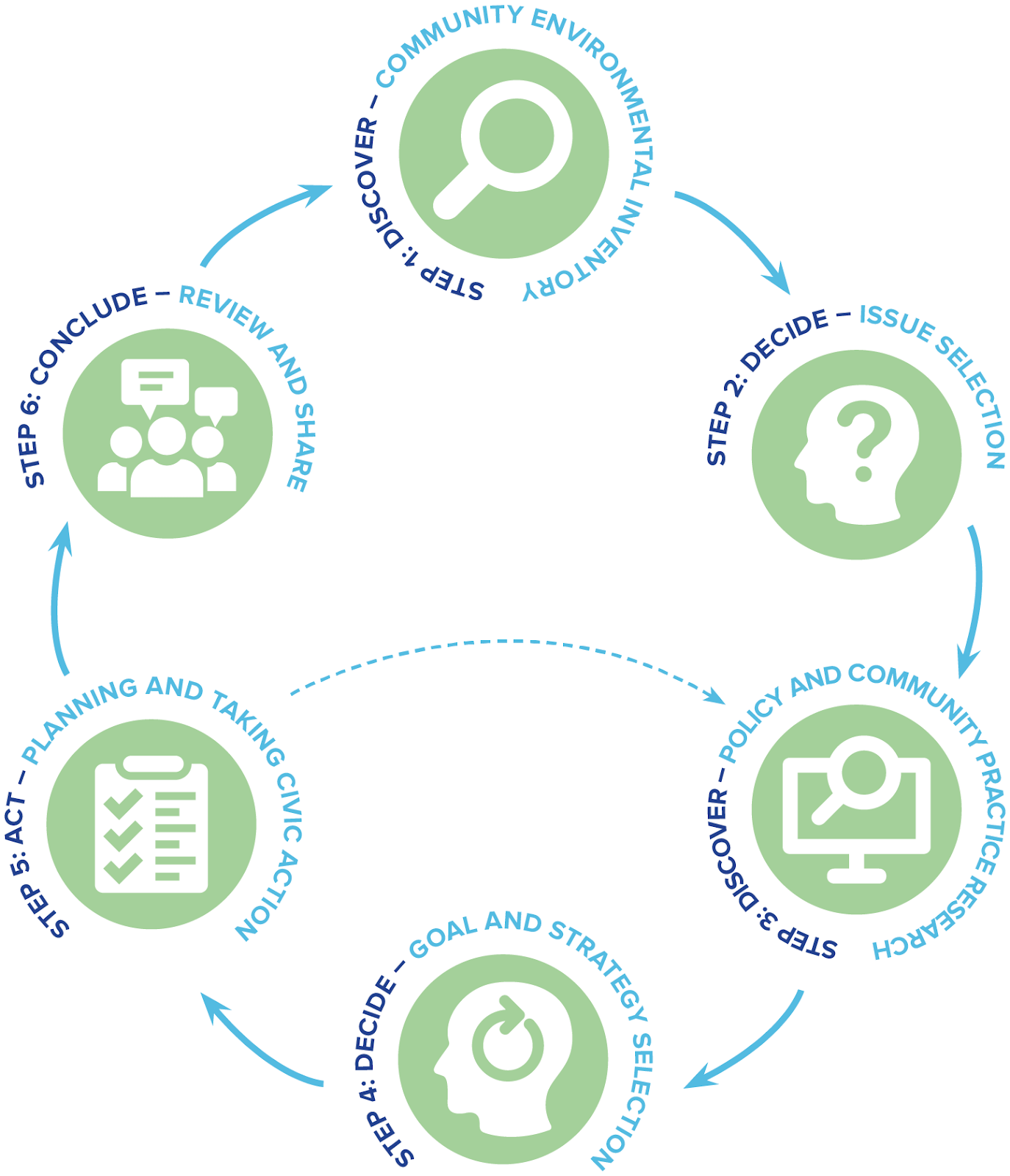Environmental Education and Civic Engagement
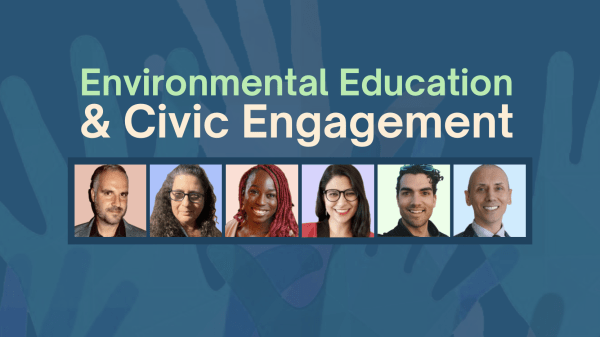
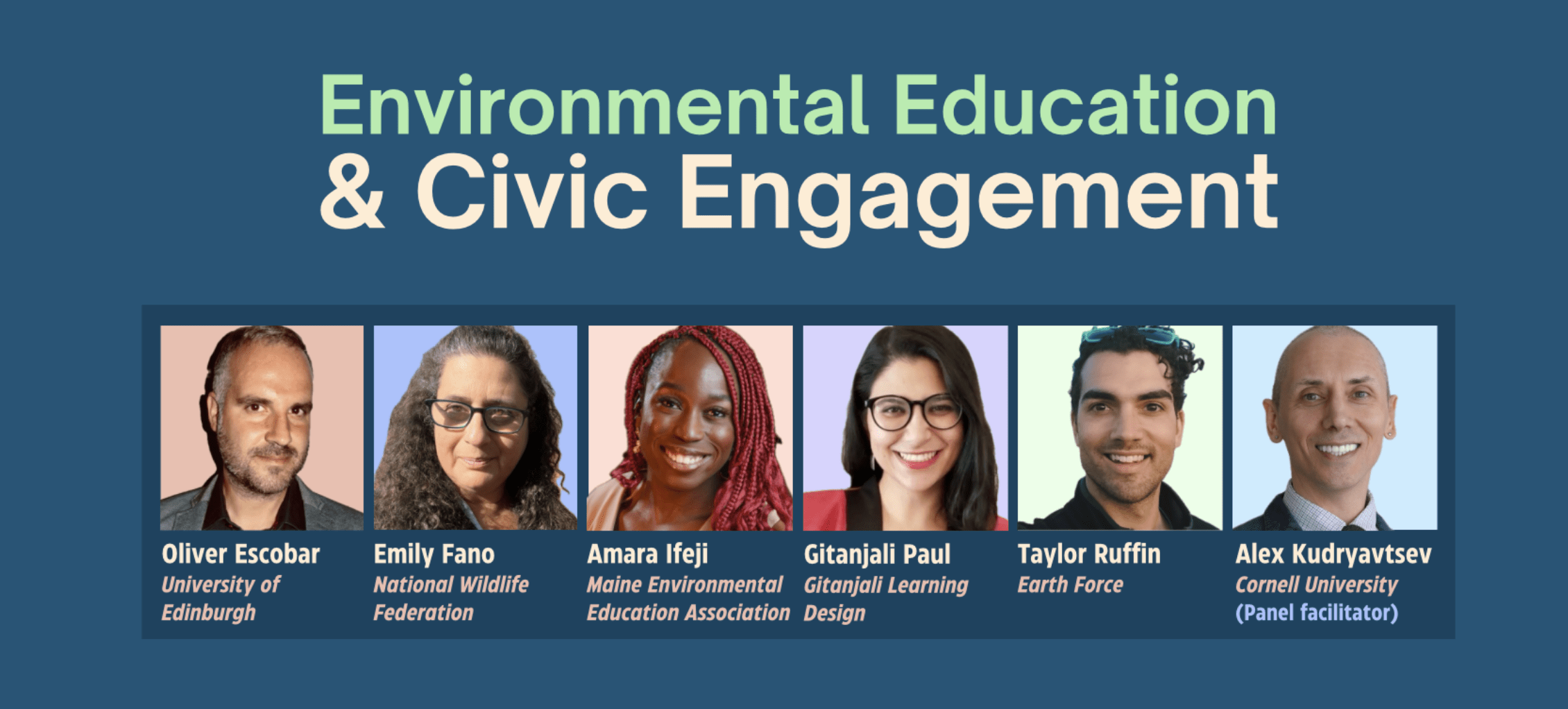

Civic engagement is vital to achieving equitable environmental governance. It fosters democratic participation, ensuring healthier ecosystems, and amplifies diverse voices in shaping environmental policies and decisions. Without strong civic engagement, environmental solutions may become unsustainable, unjust, and lack innovation.
In May 2024, our expert panel explored how environmental education can foster civic engagement, catalyzing community and ecosystem well-being, environmental justice, and equitable governance. We asked these questions: What is civic engagement? How are environmental education, civic engagement, and environmental governance related? How can environmental education foster civic engagement and democracy? How can individuals and communities be involved?
Five panelists presented their ideas, responded to attendees’s questions, and produced five essays based on their presentations. In this post, you will find a panel recording and panelists' essays.
Panel Recording
Panelists' Essays
Table of Contents
5. Unlocking Environmental Action Civics by Taylor Ruffin, Earth Force
Imagination in Action: Environmental Education, Civic Engagement and Democratic Innovation
Oliver Escobar, Professor of Public Policy and Democratic Innovation, University of Edinburgh
Environmental education entails myriad practices through which we help each other to make sense of life on Earth. This shared learning can support collective action based on ecological values and care for people and the planet. In turn, civic engagement entails myriad practices through which we help each other to work out how to live well together, and apart. This is a foundation for developing communities that strive for inclusion, wellbeing, solidarity and justice in the pursuit of common goods. Both of these fields of practice are crucial to democratic life, especially when it comes to reimagining our shared worlds and acting collectively towards desirable futures.
At their heart, the climate and ecological crises are crises of political, economic and public imagination:
- A crisis of political imagination where institutions and leaders across the world are struggling to think and act with the wisdom and urgency necessary to avert the worse possible futures of a climate-changed world.
- A crisis of economic imagination where we are locking ourselves into systems of economic organization that prioritize extraction, accumulation and exploitation over people and planet.
- A crisis of public imagination where we are led to believe that our current political and economic arrangements are the only ones possible or desirable.
Civic engagement and environmental education are key to countering these crises and rewiring these realms of imagination and action. But our legacy institutions often suffer from stagnation, complacency and incapacity, which prevents change at the pace and scale required.
Part of the problem is the issue of ‘democratic myopia’ (see Graham Smiths’ work), that is, the short-termism endemic to political and economic institutions driven by short electoral cycles and even shorter market cycles. This short-termism is reinforced by powerful actors that are in the business of squandering everyone’s tomorrow to secure their own interests today.
Another key challenge is what Dalton calls the ‘participation gap’: the growing gap between ‘the politically rich’ and the ‘politically poor’ (i.e. those who can influence the decisions that affect their lives, and those who can’t). Power inequalities feed economic inequalities, and vice versa, while dominant financial interests fuel what Nancy Fraser calls ‘cannibal capitalism’ – an economic system that destroys the very conditions for its own existence (including a liveable planet).
We are undergoing a sustained period of democratic recession globally (see for example the V-Dem reports). Traditional forms of democratic governance through legacy institutions are challenged in terms of both legitimacy and capacity. Legitimacy for meaningful action requires substantial inclusion and public trust in institutions. Capacity for effective action requires mobilizing material resources and human capabilities. If public institutions lack legitimacy, they can’t mobilize capacity; and if they lack capacity to make a difference, they lose legitimacy. This is a vicious circle that undermines the power of public institutions to effect change. But the legitimacy/capacity vicious circle can be turned into a virtuous circle.
The versions of democracy that prevail in much of the current public and political imagination are rather narrow: they are designed to be elite-driven and involve citizens in marginal ways. Citizens are entrusted to choose leaders through the ballot box, but less so to take a direct role in collective leadership efforts. Given the complexities of a climate-changed world, elite-driven forms of democratic governance are not just insufficient but counterproductive. The environmental and ecological crises require active citizens and communities supported by new institutions that can meet the challenge of imagining and enacting desirable futures.
There is a great deal of activity and hope across a range of fields at the intersection of research, policy, activism and practice. One of them is the field of democratic innovation, which seeks to rekindle democratic life by involving citizens directly in collective action, public policy and institutional decision-making. Democratic innovations are processes or institutions designed to reimagine the role of citizens in governance by increasing opportunities for participation, deliberation and influence (see Elstub and Escobar’s overview). Examples of democratic innovations include digital crowdsourcing, participatory budgeting, collaborative governance, citizens’ initiatives and deliberative mini-publics. There is an increasing number of cases covering all kinds of issues around the world, from local to regional, national, transnational and global levels of governance (see examples in Participedia).
Let’s take an example from civic engagement in environmental politics, policy and governance. In the last few years, climate assemblies (a type of deliberative mini-public) have been gaining momentum, often emerging from the interplay between civil society and public authorities in a range of countries. Climate assemblies are civic institutions where citizens selected through civic lottery learn and deliberate together about environmental issues to develop proposals and advance climate action. They seek to reflect a cross-section of the relevant population (hence the use of civic lottery) and are designed to foster the kind of high-quality deliberation that is so rare in the shallow gladiatorial arenas of our mediatised public spheres.
Climate assemblies thus foreground environmental education and civic engagement oriented towards collective climate action. In our forthcoming book Climate Assemblies: New Civic Institutions for a Climate-Changed World (Elstub & Escobar 2025) we assess their potential and limitations. They are not a panacea, but a growing number of cases across Europe (see Knowledge Network on Climate Assemblies), as well as pioneering cases such as the Global Assembly on the Climate and Ecological Crisis, are producing valuable learning for the development of the next generation of democratic innovations.
These experiences often show that citizens tend to be more ambitious than their political leaders when it comes to addressing the climate emergency. Climate assemblies tend to generate proposals that are more environmentally progressive than existing national policies (see Smith’s KNOCA report). They also offer a unique way of involving children and young people, as illustrated by the pioneering work of the Children’s Parliament as part of Scotland’s Climate Assembly in 2020-2022 (see their inspiring report). What is clear so far is that climate assemblies are building new spaces for civic engagement and environmental education –and doing so in ways that are capturing the imagination of organizations as varied as the United Nations and OECD, activist networks such as Extinction Rebellion, and governments of various ideological stripes.
Climate assemblies are just one amongst myriad democratic innovations emerging around the world. But they illustrate how new institutions can be designed to place environmental education and civic engagement at the heart of democratic governance. Navigating the troubled century ahead will require quantum leaps of imagination in action. Nothing less will do if we aspire to become, as Roman Krznaric puts it, good ancestors. This will mean developing more democratic communities, institutions and economies. For that to happen, citizenship must be more than just the act of choosing others to act on our behalf. The crises we face demand the kind of legitimacy and capacity to act that can only emerge from mobilizing democracy’s true potential for collective intelligence and action.

Photo by Delirio Perezas (shared with permission by the author)
2. Climate Education and Intergenerational Civic Engagement: A Case Study in New York
Emily A. Fano, Sr Manager, Climate Resilience Education, New York City
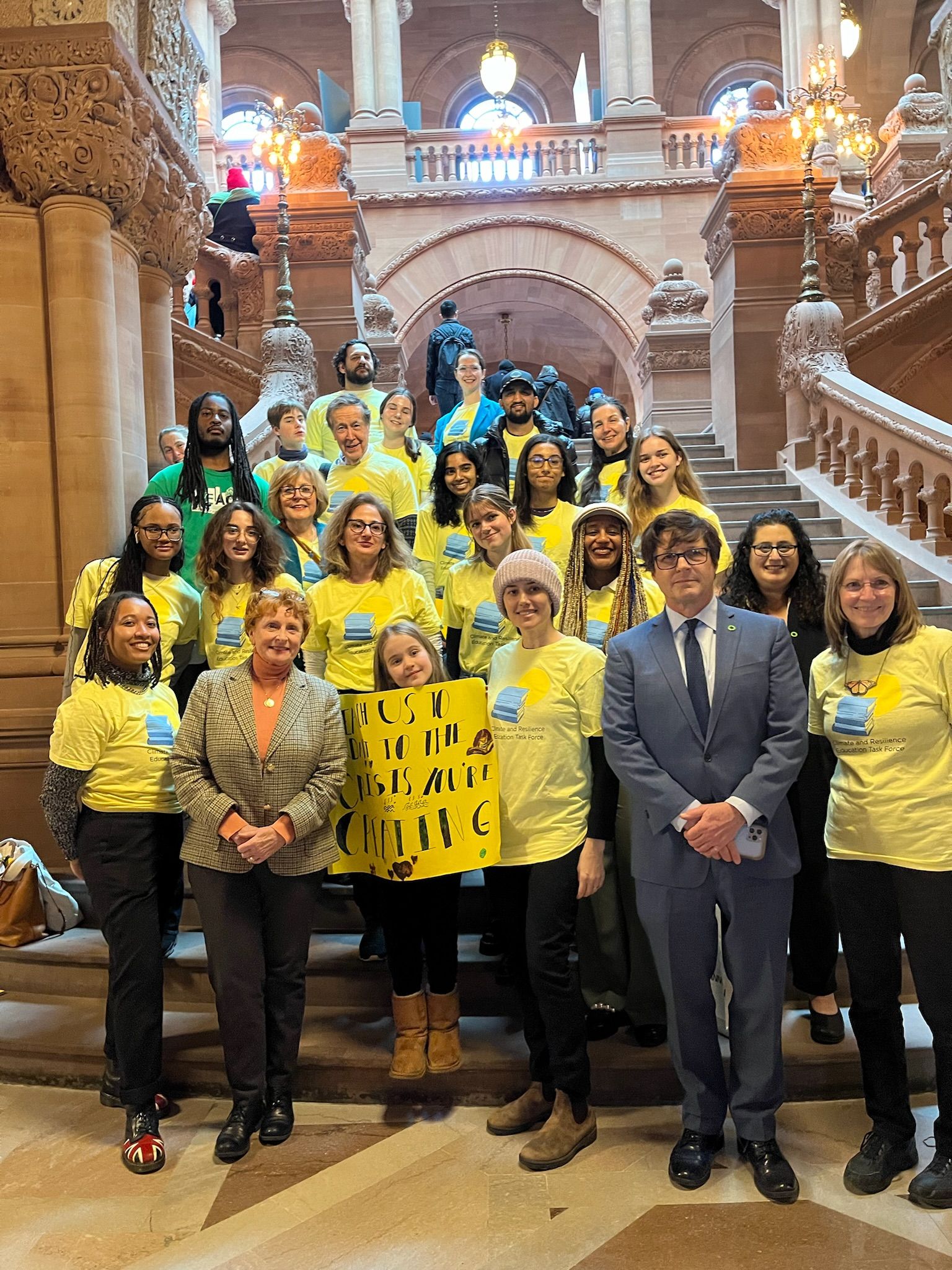
On February 6, 2024, an intergenerational group, organized by the Climate & Resilience Education Task Force, traveled to the capitol in Albany, NY to lobby for a climate education bill, S278A/A1559A.
In 2023, a series of critical climate events underscored the urgency of the situation, including unprecedented ice loss in high latitudes and potential ecosystem collapses in the Amazon and other regions. This was also the hottest year on record. Education plays a crucial role in mitigating this crisis by empowering climate-literate citizens who support sustainable policies and choose careers that help mitigate climate change. Research has shown that scaling up climate education could reduce carbon emissions comparably to large-scale interventions like electric vehicles or rooftop solar (http://doi.org/10.1371/journal.pone.0206266).
Despite the pressing need, most K–12 students in New York and throughout the U.S. receive inadequate climate education. They are often limited to no more than two hours of climate-related instruction per year, typically provided in advanced placement “Environmental Science” classes taken by less than 7% of students. This education largely overlooks crucial areas such as climate resilience, adaptation, and the broader spectrum of sustainable career opportunities. Currently, New Jersey stands out as the first state that mandates comprehensive climate literacy across all grades and subjects.
The complexity of the climate crisis calls for a holistic educational approach that includes systems thinking to understand its causes, impacts, and potential solutions. However, New York’s educational framework lacks the comprehensive, interdisciplinary curriculum needed to support its climate goals under the New York’s Climate Leadership and Community Protection Act (CLCPA), which aims for zero-emission electricity in New York by 2040. This gap in education highlights a generational injustice and undermines the state's capacity to meet its climate objectives.
The Climate & Resilience Education Task Force (CRETF), established in 2018 by the National Wildlife Federation and now co-managed with WE ACT for Environmental Justice, has developed a comprehensive plan for statewide climate education (https://www.cretf.org/our-vision). This initiative calls for updated curricula, enhanced teacher training, and the establishment of specialized programs in green technologies, aligning with New York's potential as a leader in the offshore wind and community solar sectors.
Youth activism in recent years has placed climate change at the forefront of civic engagement. It is inspired by an increasing number of people who name climate change as a top issue of concern and who support a transition to renewable energy. In this critical time, it is important to help students advocate for climate change education through rallies, meetings with elected officials, and other means. Thus, the CRETF is calling for comprehensive climate education, as highlighted by the following challenges:
- Over 40 million students annually face educational disruptions due to climate impacts.
- A majority of young people are increasingly anxious about their futures in a warming world.
- Teachers are eager to educate about climate issues but often lack the necessary training.
- Students are keen to learn about climate solutions, yet current standards tend to focus only on the problem.
3. Youth Engagement in Advancing Transformational Climate Education Policy
Amara Ifeji, Maine Environmental Education Association
As a high school student and budding environmental educator, I led stormwater monitoring efforts with my peers. This community science work enabled me to recognize the significance of education in environmental advocacy. However, I wondered how I would scale my education initiatives to positively impact students beyond my local community. Little did I know that I would soon connect with folks across the state who similarly regarded education as a critical tool for social change, nor that our advocacy efforts would ultimately culminate in the Maine Legislature investing $2+ million in a historic K-12 climate education program.
I joined the Nature Based Education Consortium and its Climate Education Advocacy working group when the pandemic shifted Maine's youth climate movement from in-person rallies to Zoom meetings. Especially during the isolating early months of the pandemic, I was grateful to meet with people across Maine who shared my vision to enhance climate and environmental awareness for Maine students. Our intergenerational, youth-led group of students, educators, and community leaders bonded around a shared background: lacking climate education in our public school experience.
Spending the first few months building trusting relationships fostered a culture of mutual respect and a way of being that values all contributions to collective work. With trust as the foundation of our work, we had the perfect recipe for a legislative campaign in 2021. This included many grassroots, youth-led groups advocating for climate education in Maine schools. This need was underscored by data supporting the need for climate education professional development for teachers, evidenced by educator feedback in the 2021 Maine Climate Education Summit and the 2019 Census for Community-Based Environmental Learning. Furthermore, Maine demonstrated governmental leadership on climate action through the Maine Climate Council. Given this momentum, we conceptualized the campaign for a climate education bill, LD 1902.
Many in our group, including myself, had never attended a public hearing nor testified for a bill. Moreover, the bill initially did not make it through the legislative council process. However, the youth in our group mobilized an effort to overturn this decision, and we were ultimately successful. In Fall 2021, we designed the bill campaign strategy, wrote the bill language, and secured bi-partisan sponsorship. It garnered immense community support with over 100 pieces of positive testimony, and the Maine Environmental Priorities Coalition selected it as a priority legislation. In April 2022, youth networks in Maine mobilized over 100 students, educators, and decision-makers to the Statehouse in Augusta to support the bill. Passed in the Maine House and Senate with a bipartisan vote, this bill was signed into law on May 9, 2022, with $2.1 million to advance climate education in Maine public schools.
Above all else, Maine’s climate education story is one of the successes in centering those most impacted by decisions in solution generation. As those who have never known a world outside of the climate crisis and who will inherit this challenge, youth are critical thought partners in climate solution generation. As such, youth voices were central to policy design and advocacy for this bill. Maine’s story is a critical example of the power of youth engagement in addressing the climate crisis.
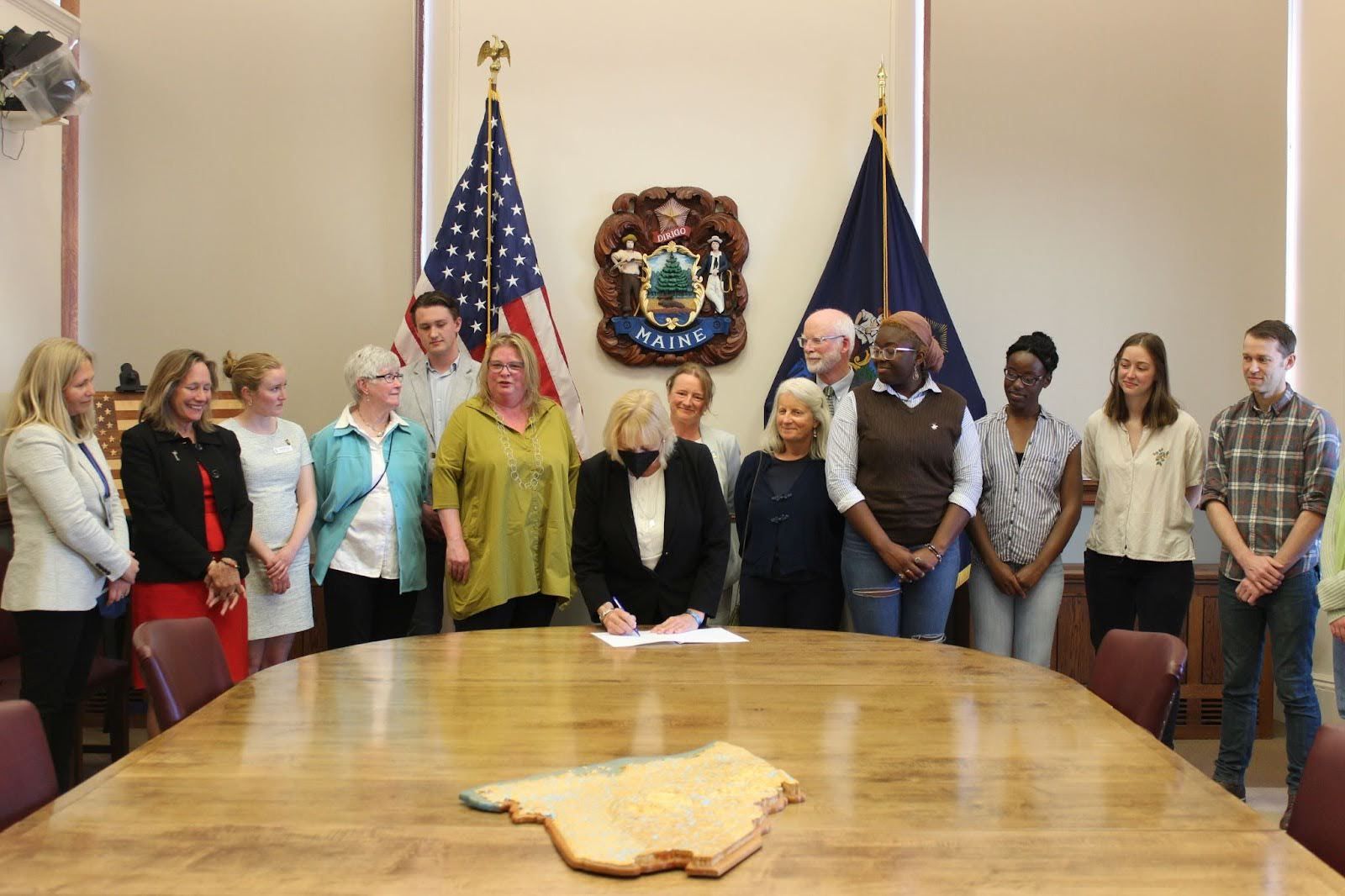
On May 9, 2022, NBEC Climate Education Advocacy Working Group members and other advocates met at the Statehouse in Augusta, ME to celebrate Governor Mills signing the climate education bill, LD 1902, into law.
4. Leveraging Systems Thinking to Further Civic Engagement for Sustainability
Gitanjali Paul, Gitanjali Learning Design
Today’s youth are inundated with a torrent of systemic problems. As educators who want to engage youth in learning and action on pressing environmental challenges, how do we inspire a generation of knowledgeable, motivated, and civically engaged youth? This challenge was at the forefront of my mind when I started my career as a high school geography and history teacher career. While learning from the past and making sense of the present, I wondered how I could help my students understand the complex issues and engage them in making a difference in our community. One of the most powerful resources I gained was a systems thinking practice.
System thinking is a way of looking at the world that explores the dynamic interrelationships of the elements around us. Systems thinking can be a valuable lens for helping our students make sense of complexity—one of the 17 essential sustainability competencies young people need to achieve the UN Sustainable Development Goals, according to the team at the World’s Largest Lesson. This is one of the many reasons systems thinking can be an asset to engaging youth in environmental education and action. When students learn to make sense of the complex world around them and contextualize themselves in a system, they realize they can impact the world, not just be impacted by it. This helps students develop the knowledge, skills, and mindsets necessary to move away from apathy and eco-anxiety towards agency and hope.
When we explore environmental issues with students, it can be tempting to approach the problems linearly. If we see trash in the park, it’s because someone littered it. If we see plastic in the ocean, it’s because we use too many plastics. These types of ‘cause’ and ‘effect’ statements are true, but they’re also remarkably oversimplified. To make systems change, we must teach them to look beyond cause and effect to think about the systemic origins of environmental problems. This deeper reflection enables them to engage in more impactful civic action.
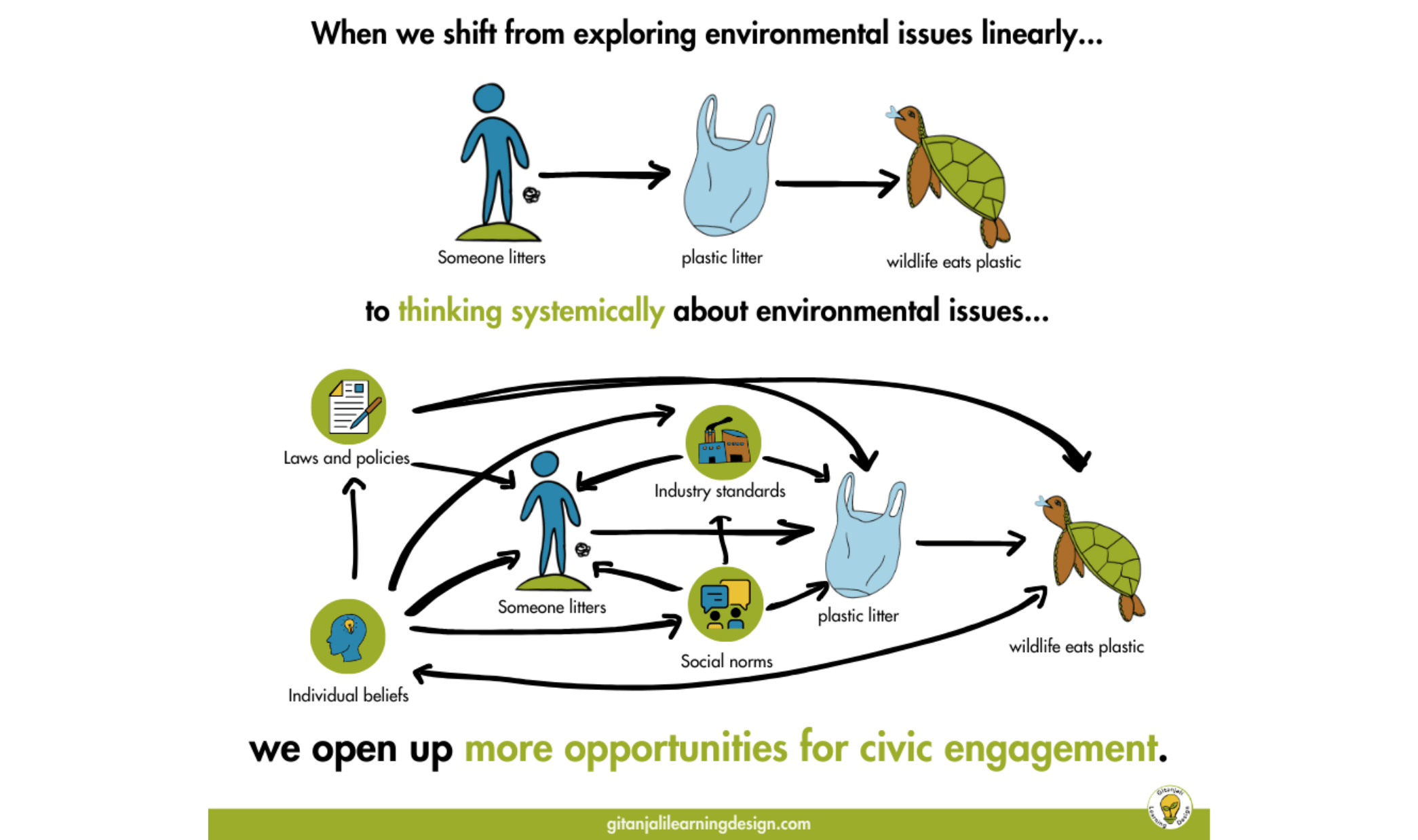
To make systems change, we must teach systems thinking. To teach systems thinking, we need systems thinking tools. Many systems thinking tools exist to help engage students in meaningful civic action to address environmental issues. The Sustainability Compass tool from the nonprofit Compass Education helps users make sustainable actions and decisions by reminding them to consider their actions through the lens of N (nature), E(economy), S(society), and individual W(wellbeing). The Systems Iceberg tool helps students dive deeper into the patterns and structures that lead to the events and problems they want to change in the world. It also helps them surface underlying mindsets and beliefs that inform our society and behaviors. Tools like causal loop diagrams help students make sense of the relationships in the world around them and tell compelling stories about how change is possible. All of these tools and more can help students visualize and engage with complex issues to identify their opportunities to make change.
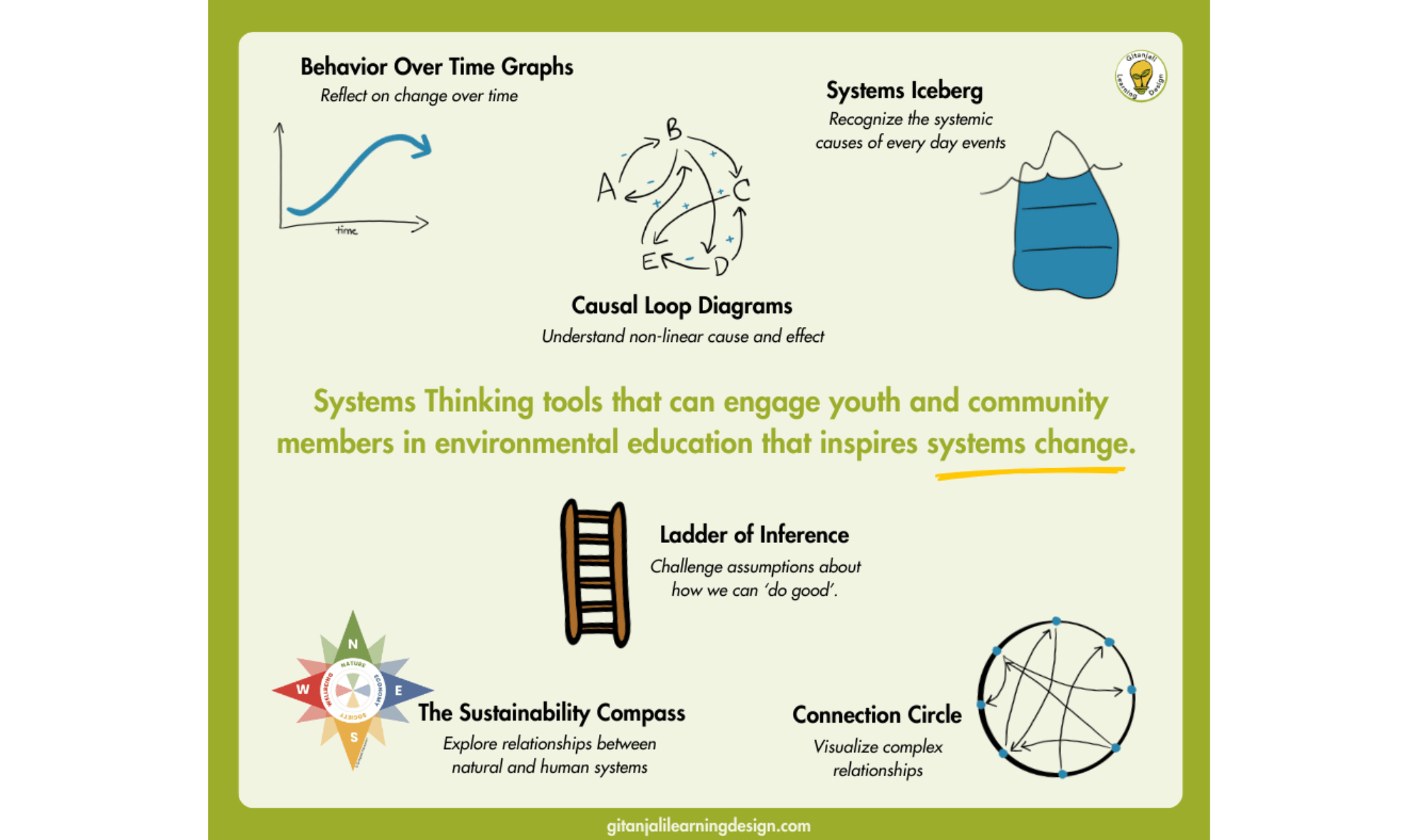
Recognizing interdependence and dynamic relationships helps students understand how their actions can impact the systems around them. This allows them to practice anticipating the effects of their action plans to mitigate possible negative externalities so they can do the most good and the least harm. It also teaches the student to find leverage points - places in a system where they can maximize the impact of our limited time, energy, and resources by targeting them with our civic action. They can help students discover the depth of their influence and autonomy so they can focus their energy on a specific goal and targets.
Inspiring and empowering students to engage in civic education to address environmental issues is essential to have a genuinely positive impact and to ‘dive deeper’ into the environmental education system. But it’s not just students who need systems thinking training and tools. It’s us – educators. Whether we work in the classroom, community centers, museums, or the great outdoors, we are connected to dozens, if not hundreds, of students each year. That means if we develop and practice systems thinking in how we approach environmental issues and share our thinking and learning with the students or community members we work with, we can have an even more significant impact on cultivating a generation of empowered, engaged individuals. Systems thinking can help us develop our own leadership as environmental educators and reassert our agency as civically engaged human beings.
5. Unlocking Environmental Action Civics
Taylor Ruffin, Earth Force
Connecting others to the wonder of the natural world has always been a focus of environmental education. At the intersection of natural and human systems, we have long seen the challenges of developing sustainable practices and policies. This is where civic engagement is critical to developing a holistic understanding of how we manage our natural resources and act as stewards for the environment. At Earth Force we emphasize facilitating a process that provides an opportunity for young folks and their adult allies to develop strategies to address environmental issues. Through this process they develop skills and gain experiences to become lifelong environmental citizens. By focusing on local issues, shared decision making and collaboration with the community, youth can affect systemic change.
Civic engagement and environmental education intersect at many points. At Earth Force we define civic engagement as any individual or group attempting to improve life in their community by advocating directly to those in power for changes they want to see. In our process, we start by focusing on the local community and defining the parameters to investigate strengths and weaknesses and identify place-based issues rooted in everyday lived experiences. This investigation creates connectivity and enthusiasm that helps drive the shared decision making between youth and adults. Collective buy in leads to collective action.
Engaging in local community issues and sharing decision making creates more opportunity to build the skills needed to become an environmental citizen. Going beyond the one-off program and focusing on a process that truly addresses the community practice or policy we seek to change. This includes action taking through the development of strategies to address environmental issues. Youth connecting with resources professionals, individuals in power and impacted community members helps construct a holistic picture of the issue and inform possible solutions. Gathering information and perspectives sets the stage for creating a strategy to action that is sustainable and strives for systemic change.
Opportunities for civic engagement can be as small as developing an ask for change. For example, youth identify an environmental issue, research a strategy that addresses that issue and connect with a person in power to request that strategy be implemented. Sometimes those efforts see little results, or those in power decline to implement the desired strategy for change. This provides a lesson in adaptation and resilience, key experiences we need to strive for systems change, as well as an opportunity to reflect on the process and celebrate hard work, regardless of outcome. In a way, civic engagement is a practice that can only be exercised through direct experience. The more we practice the more we improve our ability to create the environmental changes we wish to see.
This eePRO blog series, Ripple Effect, highlights stories of collaboration and impact among partners in the ee360+ Leadership and Training Collaborative. ee360+ is an ambitious multi-year initiative that connects, trains, and promotes innovative leaders dedicated to using the power of education to create a more just and sustainable future for everyone, everywhere. Led by NAAEE, ee360+ is made possible through funding and support from U.S. EPA and twenty-seven partner organizations representing universities and nonprofits across the country, as well as five federal agencies. Through this partnership, ee360+ brings together more than five decades of expertise to grow, strengthen, and diversify the environmental education field.






